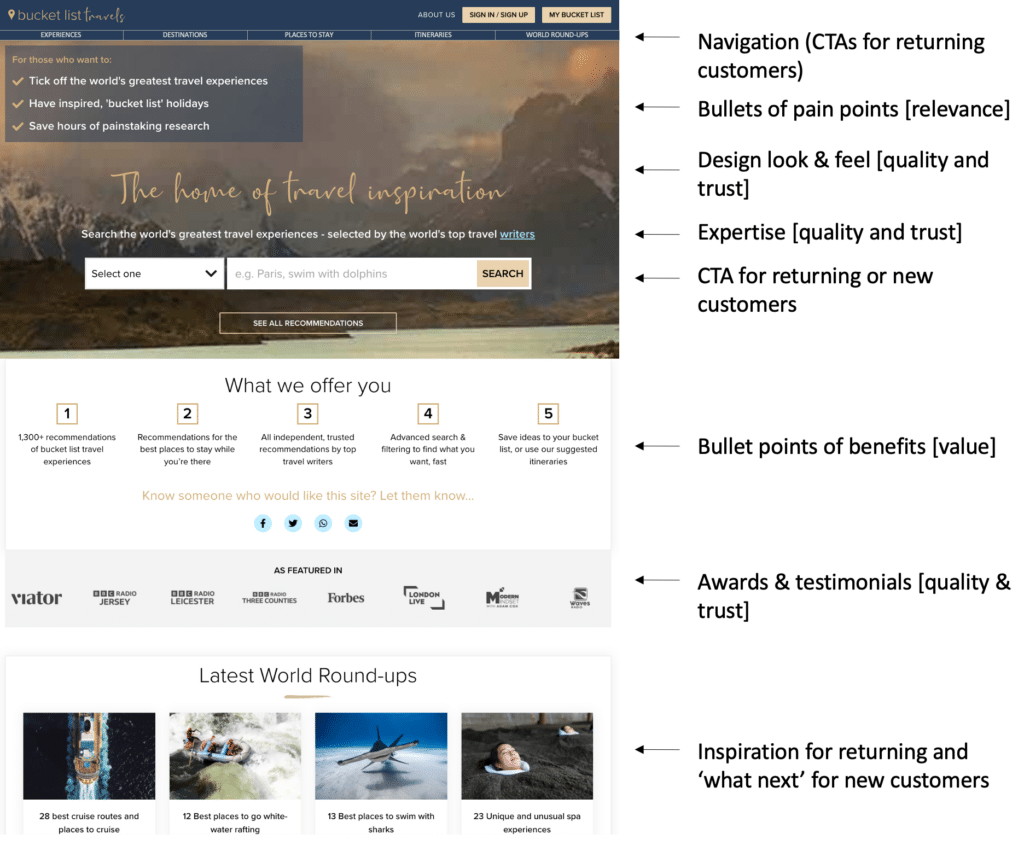Anyone working in CRO or marketing knows you only have a few seconds to hook a new customer when they land on your landing page, usually your home page. Estimates say 12s, 8s even, and now 5s.
However long it is these days, if you want them to stay, you need to answer six questions that pop into their heads – in the correct order. As follows:
- Will your product meet my unmet need, i.e., is it relevant to me? If you don’t instantly communicate that you’ve got something they want, you’ll lose them in a nanosecond. Note the relevance here – that’s where the target market comes into play. What meets a teenager’s needs may not meet those of a retiree.
If your product is meeting an unmet need of this target market, AND you communicate that quickly and effectively, then they’ll ask the following (in this order):
- What value is it to me? Most obviously, value can be for money – but it could also be time-saving, novelty, health benefits, etc.
- How good quality is this product?
- Can I trust you to deliver the product at the expected quality?
If all is good so far – you meet the need, give value and offer good quality – then comes questions of logistics:
- How simple and convenient will this purchase be?
- What will customer service be like once I’ve bought it?
And finally, if you answer all of the above:
- What do I do next?
Then you get the click and avoid the bounce – for anyone to whom it is relevant, at least.
This, then, is how a home page should be laid out. It should answer these questions in this order, as the user scrolls.
Now that you know the order, the next critical part is how to answer these questions clearly, concisely, and in a digitally-digestive manner. Here are a few common methods we’ve all seen used:
| Driver | Method |
| Relevance | – Industry Awards (direct) – Use of experts (direct) – Presence of [annoying]ads: quantity & quality (indirect) – Graphic design & colours (indirect) |
| Value | – Headline – Bullet points of benefits |
| Quality | – Chatbot – Clear contact details, e.g., Email or phone number – Clear help & FAQ sections – Photo of friendly call centre agent |
| Trust | – Industry Awards – Newspaper mentions – Testimonials – Free trial |
| Simple & convenient | – Website Usability – Free shipping – No quibble returns – 24-hour customer service – Home delivery |
| Customer service | – Chatbot – Clear contact details, e.g., Email or phone number – Clear help & FAQ sections – Photo of friendly call center agent |
| What next? | – Call to action |
Note how some of the above speak directly to the user, while others send subliminal messages to the subconscious that the user is not even always aware of.
Here’s an example of a site I’m working on called ‘Bucket List Travels’:

NB on the live site, you won’t see the list of awards – yet – as it’s only recently launched at the time of writing (October 22).
Underneath the award strip (that you can’t see above) are inspirational recommendations that users can click on once they have had their questions answered above the fold. (Or they can use the predominant search, of course).
When you land on a home page set out like this, it’s such a smooth and pleasant experience.
Now visit some home pages and see:
- Do they answer these questions?
- Do they answer in this order?
Not many do.
It’s all about the value proposition
Many people I ask don’t know what a value proposition is. Most will say it’s the product or service you deliver. That’s only half of it. Customer experience is the critical, oft overlooked second part. i.e.
Value proposition = product that meets a need + Customer Experience
The ‘customer experience’ part can be broken down into six drivers, as follows:

Look familiar? (Hint: they match the questions customers ask when they land on your home page, as above).
So, what you are actually doing on an optimized home page is effectively communicating your value proposition. That is what will make the customer stick around – assuming they have the unmet need and you have a strong enough value proposition to meet it.
Strength of the value proposition
Even if you communicate your value proposition effectively, customers won’t stick around if it’s not strong enough.
What makes it strong?
It meets an unmet need that direct competitors or alternative solutions are not meeting satisfactorily. And because of switching costs, you must meet that need significantly better.
Amazon and Uber became unicorns because they met customers’ needs significantly better than existing solutions. They delivered the same product as competitors, e.g., online bookstore and taxi – but their customer experience blew the competition away. Uber’s handy app, for example, solved two big customer pain points: not knowing when a taxi would show up and not having money to pay for one when you needed it.
In our digitally connected world, it’s very hard to offer a product no one else does – unless you have a patent – so everyone is now effectively competing on customer experience.
Returning Customers
Your landing page will also need to serve returning customers. Because they are returning, they’ve already had their questions answered, and you don’t need to do it again.
All these customers want is a call to action to get to the relevant product or information page as quickly as possible.
Therefore, you need a call to action(s) above the fold – navigation menus, a search bar, or perhaps one big call to action button. These can be easily integrated into a design that meets the needs of new customers… and hey presto!
Branding
What’s the first thing a customer sees when they land on your home page – your logo, probably your tagline, and your visual identity?
Strong branding done correctly will:
- Communicate a significant amount of your value proposition to new customers – answering many of those key questions – when they land (and sometimes even before they land), hugely increasing the chances they’ll stick around. (Yet how many CROs ever involve themselves in branding?)
- Reassure returning customers that they’ll get the same value proposition – i.e., the product/service and [pleasing] customer experience – that they had last time.
All in a microsecond! Who needs 5s?
